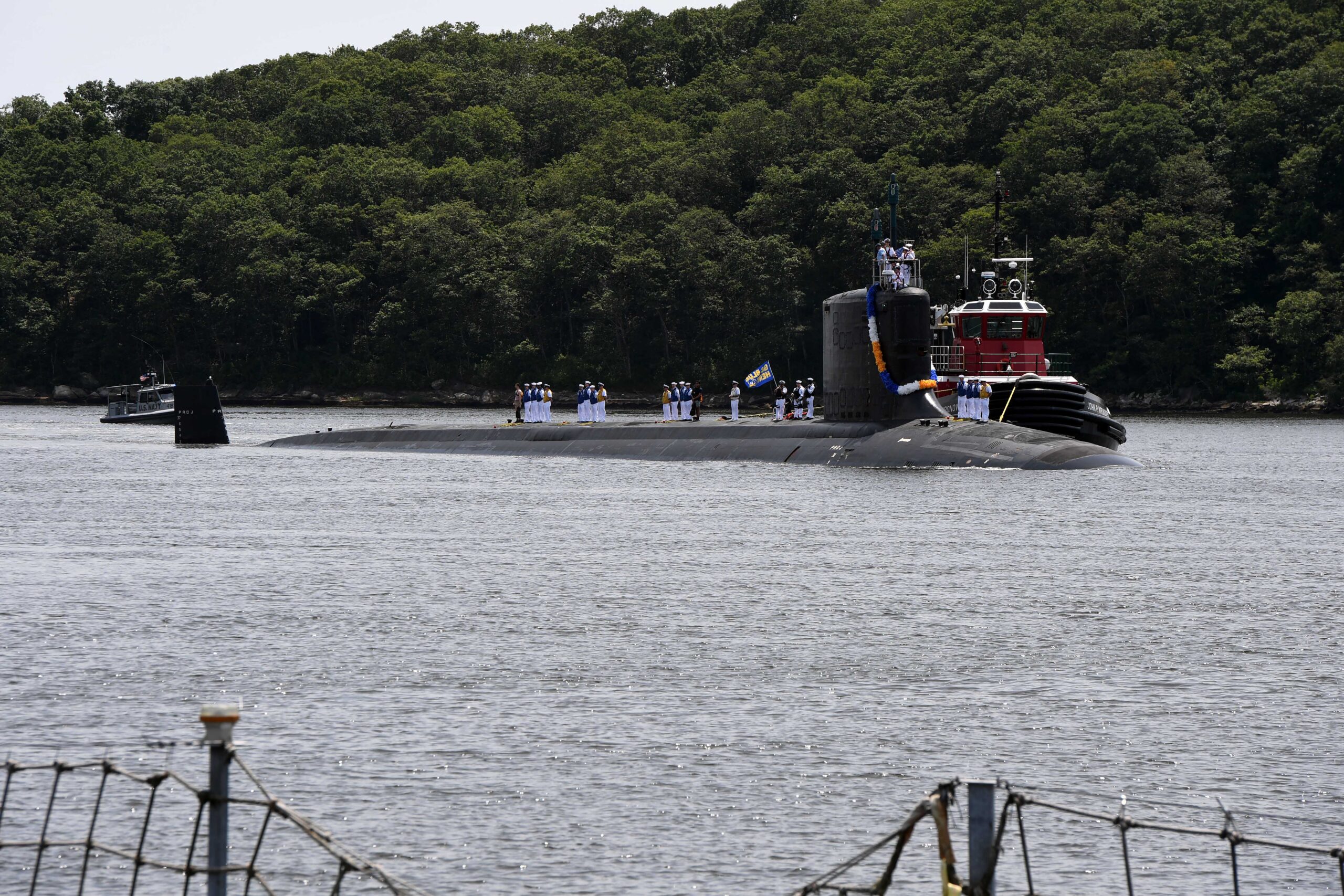The House Armed Services Committee ended a fourteen-hour markup late Tuesday by approving its Fiscal 2026 National Defense Authorization Act, 55-2. The bill injects an extra $1 billion into the Virginia-class submarine program, raises Ukraine military aid to $400 million, blocks any A-10 retirements this year and endorses a 3.8 percent pay raise for service members.
The marathon session opened at 10 a.m. and ran past 11 p.m., with members wading through more than 700 amendments. Tempers flared over proposals on missile defense cybersecurity, nuclear modernization and the future of an ex-Qatari Boeing 747 tipped as the next Air Force One. Yet the committee quickly coalesced around two priorities: sustaining submarine production and keeping weapons flowing to Kyiv.
Rep. Joe Courtney’s amendment supplies the submarine program with the full $1 billion the Navy said it lacked for the two boats requested in FY26. He covered the shortfall by trimming about two dozen lower-priority Navy accounts. “We are done pretending we can build attack boats on promises instead of money,” Courtney told colleagues.
According to industry sources, output at Electric Boat and Newport News has averaged barely 1.2 boats a year since 2022, well below the Navy’s two-per-year goal. Labor shortages, weld repairs on bow sections and delays in high-grade castings underpin the gap. The plus-up lets the Navy accelerate long-lead components and start targeted overtime at both yards.
Navy accounts trimmed to fund the $1 billion-plus up:
- $180 million from DDG-X early design work
- $140 million from Littoral Combat Ship post-delivery support
- $120 million from test-range instrumentation upgrades
- $560 million spread across depot maintenance, shore facilities and R-1 research lines
Rear Adm. Jon Rucker, the Navy’s program executive officer for attack submarines, told the panel the extra authorization “does not guarantee schedule, but without it the schedule almost certainly slips.” The amendment also lets the Navy steer up to $50 million of the plus-up into apprenticeship grants, community-college welding labs and supplier tooling – steps yard executives say are essential before Canberra’s AUKUS maintenance teams arrive next year.
Rep. Nancy Mace, R-S.C., tried to erase the $300 million Ukraine account on debt-reduction grounds; ranking member Adam Smith’s counter-move expanded it instead. The adopted language authorizes $400 million for FY 26 and FY 27, earmarking funds for air-defense interceptors, drone defeat gear, 155 mm shells and training rotations at Grafenwöhr and Yavoriv.
House-Senate delta on Ukraine aid:
- House bill: $400 million USAI
- Senate draft (approved last week): $500 million USAI
Appropriators indicated Wednesday they could accept the lower House figure if a fall supplemental addresses additional battlefield needs.
Beyond hardware, members backed a 3.8 percent basic-pay hike, raised the family-separation allowance to $400 per month and excluded housing stipends when calculating eligibility for the Basic Needs Allowance. The draft also:
- Extends an in-home child-care pilot to 2029
- Authorizes $50 million for Guard mental-health telemedicine
- Sets a floor of 5,500 child-care workers across the services
- Directs quarterly reports on barracks mold remediation
The bill bars the Air Force from retiring any A-10s in FY 26 and mandates a detailed divestment roadmap by March. Separate language blocks termination of the E-7 Wedgetail program, adds $600 million for two prototypes, and orders status briefings on F-35 Block 4 software, the nascent F-47 and F/A-XX sixth-generation fighters and V-22 modernization.
After a recent patch failure forced a 12-hour stand-down of the classified “Golden Dome” interceptor network, lawmakers tied ten percent of its FY 26 funds to delivery of a Pentagon cyber-compliance plan within 120 days. A companion section tasks the deputy defense secretary with publishing an artificial-intelligence integration roadmap, emphasizing secure data pipelines and human-machine teaming tests.
Chairman Mike Rogers cast the NDAA as a vehicle to “cut red tape and build faster.” The House draft follows his SPEED Act template: it lifts the rapid-prototyping cap to $300 million, directs major programs to adopt modular open-system architectures and lets program managers waive duplicative documentation once a design has passed critical testing. At least fifteen pilot projects – ranging from counter-drone sensors to hypersonic tracking nodes – are expected to launch under the new authorities next year.
Democrats failed to kill funding for the Qatari 747 conversion and narrowly lost a bid to censure the Pentagon for “Signalgate,” the use of unsecured apps for classified chat. They did notch a 29-29 tie that bars FY 26 dollars from reversing Confederate-base renamings – a clause Republicans pledged to challenge on the House floor.
To track submarine progress, the draft directs the Government Accountability Office to report every six months on supplier lead-times and unit-cost variance through 2028. It also orders a public dashboard, modeled on CHIPS Act reporting, that will display aggregate delivery milestones without releasing classified data – an attempt to spotlight schedule drift before year-end supplemental requests pile up.
While Ukraine dominated debate, members doubled the Taiwan Security Assistance Initiative to $1 billion and asked the Navy for a plan to mesh uncrewed surface vessels with carrier strike groups. Lawmakers from coastal districts argued that every incremental Virginia-class hull eases pressure on aging Los Angeles-class boats now forward-deployed in the Western Pacific.
The House leadership aims for floor passage during the last week of July. The Senate Armed Services Committee cleared its draft on July 11, so a conference could begin in early autumn. Staff expect talks on topline spending, Ukraine aid, submarine workforce incentives and acquisition-reform boundaries to dominate. If a final bill reaches the President before the new fiscal year, Navy comptrollers say advance contract payments for submarine suppliers could flow by mid-November; a continuing resolution would push that into January.
Our analysis shows the committee used surgical reallocations – rather than new spending authority – to shore up under-sea deterrence and allied support without breaching the $848 billion topline, a balance both chambers will have to weigh against wider strategic demands.
REFERENCE SOURCES
- https://armedservices.house.gov/news/documentsingle.aspx?DocumentID=6225
- https://www.stripes.com/theaters/us/2025-07-16/house-defense-policy-ndaa-18459099.html
- https://courtney.house.gov/media-center/press-releases/ranking-member-courtneys-bipartisan-amendment-authorize-funding-two
- https://breakingdefense.com/2025/07/hasc-adds-funds-for-virginia-class-subs-ukraine-in-fy26-policy-bill/
- https://www.quiverquant.com/news/Press%2BRelease%3A%2BRep.%2BJoe%2BCourtney%2BAdvances%2BBipartisan%2BFY26%2BNational%2BDefense%2BAuthorization%2BAct%2Bin%2BHouse%2BArmed%2BServices%2BCommittee%2BVote



